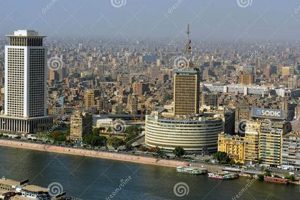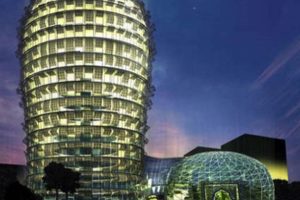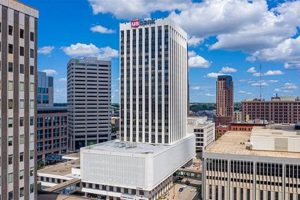Skyscrapers, towering structures reaching towards the sky, are marvels of modern architecture and engineering. Defined as buildings surpassing a specific height threshold, usually around 150 meters or 492 feet, they are iconic landmarks in major cities worldwide.
The significance of skyscrapers lies in their efficient use of urban space, allowing for high population densities in metropolitan areas. They provide ample vertical space for offices, residential units, retail stores, and various other functions, contributing to the economic vitality and vibrancy of cities. Historically, skyscrapers emerged in the late 19th century with advancements in steel-frame construction and elevator technology, forever changing urban landscapes.
In this article, we will delve deeper into the captivating world of skyscrapers, exploring their architectural marvels, engineering feats, and transformative impact on urban environments.
1. Height
In the realm of skyscrapers, height is not merely a numerical value but a defining characteristic that sets them apart from other architectural structures. The allure of reaching towards the sky, transcending the limitations of earthly constraints, has been a driving force behind the construction of these towering giants. Height in skyscrapers serves multiple purposes, both practical and symbolic, reinforcing their significance in the urban landscape.
From a practical standpoint, height allows skyscrapers to accommodate a greater number of occupants and functions within a limited footprint. This vertical expansion plays a crucial role in addressing the increasing population density of urban areas, optimizing land use and fostering vibrant, compact communities. Moreover, height enhances the efficiency of building services such as elevators and ventilation systems, enabling the smooth functioning of these vertical cities.
Beyond its practical advantages, height in skyscrapers holds immense symbolic value. These towering structures often serve as beacons of economic prosperity and urban pride, representing the ambition and achievements of the cities they inhabit. The race to construct the tallest building has been a recurring theme throughout history, with each new architectural marvel pushing the boundaries of engineering prowess and becoming an iconic landmark. From the Empire State Building to the Burj Khalifa, these skyscrapers have become synonymous with the cities they grace, embodying the spirit of innovation and human endeavor.
In conclusion, the height of skyscrapers is not just a physical attribute but an integral part of their identity and purpose. It enables efficient space utilization, enhances building functionality, and serves as a symbol of urban progress and achievement. Understanding this connection is essential for appreciating the significance of skyscrapers and their transformative impact on the modern urban environment.
2. Structure
The structure of a skyscraper is its backbone, providing the strength and stability necessary to withstand the forces of nature and human activity. Skyscrapers rely on two primary materials: steel and concrete, each playing a crucial role in creating these architectural marvels.
- Steel skeletons: The framework of a skyscraper is typically constructed using steel, a strong and lightweight material that allows for flexible and efficient design. Steel beams and columns form the primary structure, providing the skyscraper with its shape and strength. This skeletal framework is essential for resisting lateral forces such as wind and earthquakes.
- Concrete giants: Concrete, a composite material made from cement, sand, gravel, and water, is used to fill in the steel framework and create the floors, walls, and other structural elements of a skyscraper. Concrete provides compressive strength and fire resistance, making it an ideal material for high-rise buildings.
The combination of steel and concrete creates a structure that is both strong and resilient, enabling skyscrapers to soar to unprecedented heights and withstand the challenges of their environment. These materials have revolutionized the construction of skyscrapers, allowing architects and engineers to push the boundaries of architectural design and create iconic landmarks that shape the skylines of cities around the world.
3. Function
Skyscrapers, with their towering heights and expansive floor plans, embody the concept of vertical cities within cities. This multifaceted functionality is a defining characteristic that sets skyscrapers apart and contributes to their significance in the urban landscape.
- Mixed-use spaces: Skyscrapers often house a diverse range of functions within a single structure, including offices, residential units, retail stores, restaurants, and recreational facilities. This mixed-use approach creates a self-contained environment that caters to a variety of needs, reducing the need for commuting and fostering a sense of community.
- Vertical transportation: Elevators and other vertical transportation systems are essential to the functionality of skyscrapers, enabling efficient movement of people and goods between floors. Advanced elevator technologies, such as double-decker elevators and high-speed lifts, optimize traffic flow and minimize wait times, ensuring seamless connectivity throughout the building.
- Sustainability and resilience: Modern skyscrapers incorporate sustainable design features to reduce their environmental impact and enhance resilience in the face of natural disasters. Green roofs, rainwater harvesting systems, and energy-efficient building materials contribute to sustainability, while earthquake-resistant structures and backup power systems ensure the safety of occupants during emergencies.
- Urban planning and density: Skyscrapers play a crucial role in urban planning, allowing for high population densities in central areas while preserving valuable land space. By concentrating development vertically, skyscrapers contribute to compact and walkable cities, reducing urban sprawl and promoting efficient land use.
In conclusion, the function of skyscrapers as vertical cities within cities is a testament to their versatility and adaptability. They provide comprehensive environments that cater to a wide range of urban needs, optimize space utilization, enhance connectivity, and promote sustainable and resilient urban development. Understanding this functional aspect is key to appreciating the multifaceted nature of skyscrapers and their transformative impact on the modern urban landscape.
4. Density
Skyscrapers emerged as a direct response to the need for maximizing urban space in densely populated areas. The ability to build vertically allowed cities to accommodate a growing population without sprawling endlessly outward, preserving valuable land for other purposes such as parks, green spaces, and essential infrastructure.
The concept of density plays a pivotal role in understanding the significance of skyscrapers. By concentrating development vertically, skyscrapers enable cities to achieve higher population densities while minimizing their physical footprint. This compact urban form promotes efficient land use, reduces urban sprawl, and fosters walkability, creating more sustainable and livable urban environments.
Real-life examples abound, showcasing the transformative impact of skyscrapers on urban density. In New York City, the construction of skyscrapers has allowed the metropolis to house a vast population within a relatively small geographic area. Similarly, in Hong Kong, skyscrapers have enabled the city to maintain its status as a global financial hub despite its limited land resources.
Understanding the connection between density and skyscrapers is crucial for urban planning and sustainable development. By maximizing urban space, skyscrapers contribute to the creation of vibrant, compact cities that prioritize quality of life, environmental sustainability, and economic prosperity.
5. Sustainability
The connection between sustainability and skyscrapers lies in the growing recognition of the environmental impact of buildings and the need for more sustainable urban development. Skyscrapers, with their massive scale and energy consumption, have the potential to significantly contribute to greenhouse gas emissions and other environmental concerns. As a result, embracing green innovation has become an essential aspect of modern skyscraper design and construction.
Sustainable skyscrapers incorporate a range of eco-friendly features and technologies to reduce their environmental footprint. These include energy-efficient lighting systems, solar panels, rainwater harvesting systems, and green roofs. Some skyscrapers have even been designed to achieve net-zero energy consumption, generating as much energy as they consume through renewable sources. The Burj Khalifa, for example, the world’s tallest building, utilizes a cladding system that generates electricity from solar energy.
Understanding the importance of sustainability in skyscraper design is crucial for several reasons. Firstly, it helps mitigate the environmental impact of these massive structures, reducing their carbon footprint and promoting sustainable urban development. Secondly, it aligns with the growing demand for green buildings, as tenants and occupants increasingly prioritize environmentally responsible spaces. By embracing sustainability, skyscrapers can contribute to the creation of healthier and more sustainable cities for the future.
6. Engineering
The connection between “Engineering: Defying gravity’s pull” and “what are skyscrapers” lies at the heart of skyscraper design and construction. Skyscrapers, with their towering heights, are a testament to the ingenuity and skill of engineers who have pushed the boundaries of structural engineering to create these architectural marvels.
Engineering plays a pivotal role in defying gravity’s pull, ensuring that skyscrapers can withstand the forces of nature and remain stable. Structural engineers employ a range of techniques to achieve this, including:
- Strong foundations: Skyscrapers require deep and sturdy foundations to anchor them firmly in the ground. These foundations distribute the weight of the building evenly and prevent it from sinking or toppling over.
- Steel frames: The primary structure of most skyscrapers consists of a steel frame. Steel is a strong and lightweight material that can withstand high compressive and tensile forces, making it ideal for constructing tall buildings.
- Reinforced concrete: Concrete is used to fill in the steel frame and create the floors, walls, and other structural elements of a skyscraper. Concrete provides compressive strength and fire resistance, enhancing the overall stability of the building.
- Wind bracing: Skyscrapers are designed to withstand strong winds, which can cause them to sway. Wind bracing systems, such as diagonal beams and trusses, are incorporated into the structure to resist lateral forces and prevent excessive movement.
Understanding the engineering behind skyscrapers is crucial for appreciating the complexity and challenges involved in constructing these architectural wonders. Engineers must carefully consider factors such as wind loads, seismic activity, and material properties to ensure the safety and stability of these towering structures.
7. Architecture
Skyscrapers, as architectural marvels, embody the creative vision and artistic prowess of architects. The connection between “Architecture: Artistic expressions in the sky” and “what are skyscrapers” lies in the unique opportunity that skyscrapers provide for architects to showcase their creativity and push the boundaries of architectural design.
- Form and Function: Skyscrapers are not merely functional structures; they are also expressions of architectural artistry. Architects carefully consider the form and shape of skyscrapers, using innovative designs to create visually striking and iconic landmarks. The Empire State Building, with its Art Deco style, and the Burj Khalifa, with its sleek and futuristic form, exemplify the fusion of aesthetics and functionality in skyscraper architecture.
- Facade Design: The facades of skyscrapers serve as canvases for architectural creativity. Architects employ various materials and techniques to create unique and visually captivating exteriors. The glass curtain walls of the John Hancock Center in Chicago reflect the city’s skyline, while the terracotta facade of the Flatiron Building in New York City adds a touch of historical charm to the urban landscape.
- Vertical Gardens and Green Spaces: Incorporating greenery into skyscraper design has become an increasingly popular trend. Vertical gardens and rooftop terraces not only enhance the aesthetics of buildings but also provide environmental benefits and improve air quality. The Bosco Verticale in Milan, Italy, features cascading gardens on its balconies, creating a unique and sustainable residential complex.
- Lighting Design: At night, skyscrapers transform into illuminated beacons, adding a touch of magic to the urban skyline. Architects use creative lighting techniques to highlight architectural features, create dynamic light displays, and enhance the overall visual impact of their designs. The One World Trade Center in New York City utilizes LED lights to create a mesmerizing light show that changes throughout the year.
In conclusion, “Architecture: Artistic expressions in the
sky” is an integral aspect of “what are skyscrapers.” Skyscrapers provide a unique canvas for architects to showcase their creativity, push architectural boundaries, and create visually stunning landmarks that shape the character and identity of cities worldwide.
8. Iconography
Skyscrapers, as towering symbols of human ambition, have become iconic landmarks that embody economic power and urban pride. The connection between “Iconography: Symbols of economic power and urban pride” and “what are skyscrapers” lies in the unique role that skyscrapers play in shaping the identity and perception of cities.
- Economic Power: Skyscrapers have long been associated with economic prosperity and financial might. The construction of skyscrapers is often seen as a sign of a city’s economic strength and ambition. Cities with impressive skylines, such as New York City, Dubai, and Shanghai, are often perceived as global financial hubs and centers of commerce.
- Urban Pride: Skyscrapers also serve as symbols of urban pride and identity. They represent the achievements and aspirations of a city’s residents and contribute to a sense of place and belonging. Iconic skyscrapers, such as the Eiffel Tower in Paris or the Sydney Opera House in Australia, have become synonymous with the cities they call home.
- Cultural Significance: Skyscrapers have transcended their functional purpose and have become cultural icons. They have been featured in countless works of art, literature, and film, shaping popular perceptions of urban life and modernity. The Empire State Building, for example, has become an enduring symbol of New York City and American culture.
- Tourism and Identity: Skyscrapers are often major tourist attractions, drawing visitors from around the world. They offer breathtaking views, observation decks, and unique architectural experiences. In cities like Dubai, skyscrapers have become central to the tourism industry, contributing to the city’s global recognition and economic growth.
In conclusion, the connection between “Iconography: Symbols of economic power and urban pride” and “what are skyscrapers” is multifaceted. Skyscrapers serve as physical manifestations of economic strength, urban pride, cultural significance, and tourist attractions, shaping the identity and perception of cities worldwide.
Frequently Asked Questions about Skyscrapers
Skyscrapers, with their towering heights and architectural marvels, often raise questions and curiosities. Here are answers to some of the commonly asked questions about skyscrapers:
Question 1: What is the defining characteristic of a skyscraper?
Skyscrapers are defined as buildings that exceed a specific height threshold, typically around 150 meters or 492 feet. This height requirement distinguishes them from other tall buildings and contributes to their iconic status in urban landscapes.
Question 2: What are the primary materials used in skyscraper construction?
Skyscrapers primarily utilize two essential materials: steel and concrete. Steel provides the framework and structural support, while concrete fills in the framework to create floors, walls, and other structural elements. The combination of these materials ensures strength, stability, and fire resistance.
Question 3: How do skyscrapers address the challenge of wind forces?
To withstand strong winds and lateral forces, skyscrapers employ wind bracing systems. These systems, consisting of diagonal beams and trusses, are incorporated into the structure to resist wind loads and prevent excessive swaying. This ensures the stability and safety of the building during high winds.
Question 4: Are skyscrapers designed to be environmentally sustainable?
Modern skyscrapers increasingly incorporate sustainable design features to reduce their environmental impact. Green roofs, rainwater harvesting systems, energy-efficient lighting, and solar panels are common features in sustainable skyscrapers. These features contribute to energy efficiency, water conservation, and a reduced carbon footprint.
Question 5: How do skyscrapers contribute to urban planning and density?
Skyscrapers play a crucial role in urban planning by maximizing space utilization and promoting higher population densities. By building vertically, skyscrapers reduce urban sprawl and preserve valuable land for other purposes, such as parks and green spaces. This contributes to compact and sustainable urban development.
Question 6: What is the cultural significance of skyscrapers?
Skyscrapers have become iconic symbols of economic power, urban pride, and technological advancement. They represent the ambition and achievements of cities and have featured prominently in art, literature, and film. Skyscrapers serve as landmarks that shape the identity and global recognition of cities.
In summary, skyscrapers are marvels of engineering and architecture, embodying the pursuit of height, innovation, and urban density. They contribute to sustainable development, shape urban landscapes, and hold cultural significance as symbols of progress and achievement.
Transition to the next article section…
Skyscraper Design Tips
Skyscrapers, with their towering heights and architectural significance, require careful planning and innovative design strategies. Here are some essential tips to consider when designing skyscrapers:
Incorporate Mixed-Use Spaces:Maximize space utilization by designing skyscrapers with a mix of functions, such as offices, residential units, retail stores, and recreational facilities. This creates a self-contained vertical community that reduces the need for commuting.
Emphasize Vertical Transportation:Prioritize efficient vertical transportation systems, including elevators and escalators, to facilitate the movement of people and goods within the skyscraper. Consider advanced technologies like double-decker elevators and high-speed lifts to optimize traffic flow.
Implement Sustainable Features:Incorporate green building practices to reduce the environmental impact of skyscrapers. Utilize energy-efficient lighting, install solar panels, and consider rainwater harvesting systems to conserve resources and promote sustainability.
Consider Wind Resistance:Design skyscrapers to withstand strong wind forces. Employ wind bracing systems, such as diagonal beams and trusses, to resist lateral loads and prevent excessive swaying. This ensures the structural integrity of the building during high winds.
Prioritize Safety and Security:Incorporate robust safety and security measures into the design. Install fire sprinklers, smoke detectors, and emergency escape routes to ensure occupants’ safety in case of emergencies. Implement access control systems and surveillance cameras to enhance security.
By adhering to these design tips, architects and engineers can create skyscrapers that are not only structurally sound and aesthetically pleasing but also sustainable, efficient, and safe for occupants.
In conclusion, designing skyscrapers requires a holistic approach that balances architectural vision, engineering expertise, and a commitment to sustainability and human well-being.
Conclusion
Skyscrapers, with their towering heights and architectural marvels, have reshaped urban landscapes and become symbols of progress and ambition. Throughout this article, we have explored the mu
ltifaceted aspects of skyscrapers, including their height, structure, function, density, sustainability, engineering, architecture, iconography, and design.
Skyscrapers are more than just tall buildings; they are vertical cities within cities, accommodating a multitude of functions and fostering vibrant communities. They represent the ingenuity of engineers and the creativity of architects, pushing the boundaries of structural design and artistic expression. As symbols of economic power and urban pride, skyscrapers contribute to the identity and global recognition of cities.
As we look towards the future of skyscrapers, sustainability and innovation will play an increasingly important role. Architects and engineers will continue to explore new ways to reduce the environmental impact of these massive structures while enhancing their functionality and safety. The pursuit of height and architectural excellence will undoubtedly continue, but it will be tempered by a growing awareness of the need for sustainable and resilient urban development.
Skyscrapers, as testaments to human ambition and ingenuity, will continue to grace the skylines of cities around the world. They serve as reminders of our capacity for innovation and our to build structures that reach for the sky.







